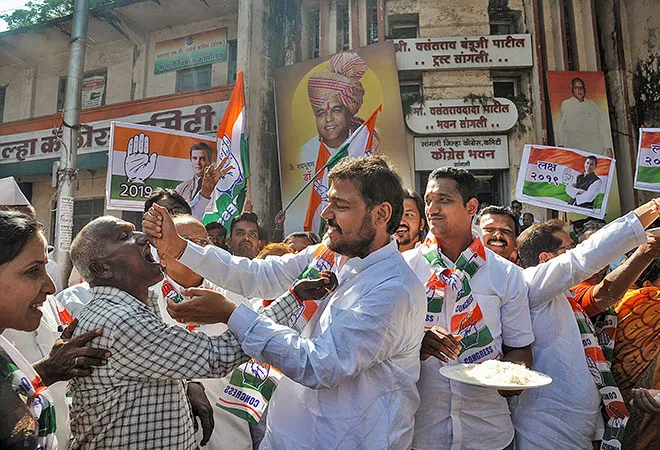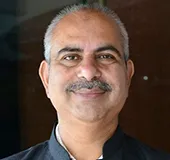-
CENTRES
Progammes & Centres
Location

Image Source: PTI
After good performance in the recent Assembly elections, , the Congress story, precipitously, is looking up and bright. Just like Sonia Gandhi of December 1998, her son Rahul Gandhi has emerged, with a dash of promise.
The outcome of five State assembly polls, in particular, Madhya Pradesh, Rajasthan and Chhattisgarh, are a sweet music for every Congressperson and its sympathiser, more in the context of grand old party’s survival and primacy of Nehru-Gandhi family in national politics.
First and foremost, the electoral success has thrown a rather real possibility of a “Congress-mukt Bharat” out of the window. The party under Rahul lives to fight, not just for another day but armed with prospects of denying the mighty Narendra Modi a chance to extend his lease of office for five more years. He may still be the Prime Minister after May 2019, but days of single-party majority are, for all practical purposes, over. Modi was seen holding fort till around 4.30 pm on the last day of campaigning in Rajasthan where the subtext of his speeches was a call for a vote for his personal prestige. Anything and everything related to communal rhetoric was played up to the hilt, but the results were disappointing and, in fact, adverse. From Jammu and Kashmir to Gujarat, there are 273 Lok Sabha seats in this “cow belt” where the BJP and its allies are holding on to a whopping 226. A shortfall of 80 to 100 seats looks likely if the Samajwadi Party (SP) and Bahujan Samaj Party (BSP) come together in all-important Uttar Pradesh.
In such a scenario, Modi, if he succeeds in stitching together a ragtag coalition, would face hawkish, temperamental and demanding allies in exchange for running the government between 2019 and 2024 with barely 200 seats of his own in the kitty.
The Rahul Gandhi-led Congress needs to do a lot more in order to be in contention for a 100-plus figure in the 17th Lok Sabha. Ideological clarity on a raft of issues, including Ram Temple, is crucial.
In the weeks to come, Rahul Gandhi has to guard himself against a liberal-Leftist narrative that has a potential of alienating the majority community. At the same time, over-reliance on identifying with the Hindu faith could boomerang in southern and eastern parts of India where Hindu-Muslim social relations are not as precarious as in the heartland States.
Rahul Gandhi’s band of chief ministers, namely Amarinder Singh, Kamal Nath, Ashok Gehlot, Bhupesh Baghel and V Narayanasamy, have to set numerous examples of good governance, addressing complex issues ranging from agrarian distress, job creation to social harmony from now till April 2019 when campaigning for the parliamentary polls is set to peak. As a former commerce and industries minister and nine-time Lok Sabha winner, Nath believes in the cash-and-delivery method. He is capable of drawing big industrialists towards “destination Madhya Pradesh” rather quickly. If the Chhindwara model of development is spread all over the central Indian State, agriculture, infrastructure and the services sector may start showing promise in the coming days.
A rather understated Gehlot, who comes from a family of magicians, has a few tricks up his sleeve. For instance, in the 1980s, he was a young minister of state for tourism under Rajiv Gandhi when he hit upon the idea of setting up a “Dilli Haat” in south Delhi.
Since then, the plaza has become a must-visit destination not only for city residents but millions of visitors who get to see a fascinating panorama of craft, cuisine and cultural activities in two square kilometres.
The outcome of the Chhattisgarh assembly polls offers an interesting insight: Indian voters tend to be highly volatile and demanding. Dr Raman Singh enjoyed a reasonably good image and many economic indicators showed that the tribal State was not doing poorly. Unlike Madhya Pradesh or Rajasthan, the Congress did not have a Jyotiraditya Scindia, Kamal Nath, Ashok Gehlot or Sachin Pilot as an alternative. Yet, the voters emphatically rejected the premise that India was increasingly heading towards a personality-driven polity, a US- style presidential or a prime ministerial democracy. The presence of Narendra Modi, Amit Shah and Rajnath Singh made no difference to voters, let alone the promotion of the legacy of the late prime minister Atal Bihari Vajpayee whose posters and banners were put up all over the State.
The 2019 parliamentary polls are primed to be contested in contrasting styles. If Team Modi is set to make full use of the Prime Minister’s personal ratings, big-ticket projects, surgical strike, achievements on the diplomatic front and reliance on emotive issues like Ram Temple, the Congress and its potential allies are prepared to take the battle to the States where regional players are expected to hold sway.
So, if Mamata Banerjee, Lalu Prasad, Sharad Pawar, MK Stalin, Naveen Patnaik, V Kumaraswamy, N Chandrababu Naidu and the Mayawati-Akhilesh combine manage to hold on to a bulk of the parliamentary seats, the Congress has the job of doing well in Rajasthan, Haryana, Punjab, Jharkhand, Madhya Pradesh, Chhattisgarh, Karnataka, Himachal Pradesh, Uttarakhand, Assam and other north-eastern States, Gujarat, and parts of Maharashtra where it is in a direct contest with the BJP.
In the Congress circles, there is already talk of targeting “half of half”, i.e. about half of 273 Lok Sabha seats on its own – a challenging but not unmanageable number. The non-NDA opposition is expected to score over the other “half of half’ in Uttar Pradesh, Odisha, West Bengal, Tamil Nadu, Andhra Pradesh, Bihar, Delhi and the rest of the States.
In Sonia Gandhi, Rahul Gandhi has someone to fall back on as a line of communication with many non-NDA allies, including the Left, to keep the ‘mahagathbandhan’ (grand alliance) going in several States. Years in politics have made Sonia Gandhi one of the finest graduates from the university of life. Throughout the UPA years of 2004-2014, her acumen and finesse, deftly mixing “economic Right with social Left”, worked well until illness took a huge toll on her.
If Rahul Gandhi revives his mother’s practice of holding six-monthly conclaves of Congress chief ministers, periodically monitoring their progress, the young party president may himself find the interaction enriching and rewarding, giving almost first-hand insight into governance.
In any case, like Sonia Gandhi, her son too does not fancy himself as a power-wielder but a trustee of power. This unique profile keeps stoking the prime ministerial ambitions of many regional satraps who feel the Gandhi scion would prefer to bid for the top job in 2024, and not in 2019.
The assembly polls have given a peep into Rahul Gandhi’s leadership style of functioning. In selecting three chief ministers of Madhya Pradesh, Rajasthan and Chhattisgarh, 1970-born Rahul Gandhi has shown healthy regard for constructive dissent, experience and organizational commitment. In two out of three cases, he has chosen State party presidents. Both Kamal Nath and Bhupesh Baghel had toiled hard and fought an epic battle against 15 years of BJP rule.
The uneasiness in the selection of Ashok Gehlot in Rajasthan and to a lesser extent, Baghel in Chhattisgarh, showed a redeeming side of Rahul Gandhi. Unlike his father and grand mother as head of the Congress, Rahul Gandhi displayed his knack to play by the ear, a rarity in all-imposing “high command” structure of the grand old party. At one level, it gave an impression that Rahul Gandhi was not in command when some enthusiastic Gujjar leaders exhibited ugly face of lawlessness, stopped running trains and torched vehicles. For some, the AICC chief’s stand can also amount to sending out a subtle message as regional, linguistic, caste-based aspirations, equal opportunities, lobbying and pressure was alive (even as the expense of their inherent malice) and kicking in a ‘vibrant’ political party as against “two persons rule” in the other side of the political spectrum. Whether these optics find any resonate in the political discourse as part of run-up for 2019 is something that remains to be seen.
The views expressed above belong to the author(s). ORF research and analyses now available on Telegram! Click here to access our curated content — blogs, longforms and interviews.

Rasheed Kidwai is Visiting Fellow at Observer Research Foundation. He tracks politics and governance in India. Rasheed was formerly associate editor at The Telegraph, Calcutta. He ...
Read More +